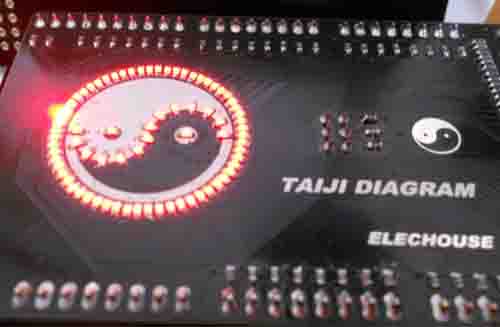#TAJIUINO DUE#
Taijiuino DUE is an Arduino-like board derives from Arduino DUE, it is designed by Elechouse.
Details
Hardware
Schematic and Gerber files of Taiji-Uino board.
Software
Sample code to demonstrate how to use Arduino DUE
-
rtled turn on LEDRX and turn off LEDTX for 0.5 second, then turn off LEDRX and turn on LEDTX for 0.5 second, repeatedly.
-
taijidiagram Demonstrate how to make Native USB into a serial port, this program controls all the GPIOs to turn on or turn off the LEDs which are connected to the GPIO, work together with TaijiDiagram, is used to test the TaijiUino Due, a bit like this:
-
additional_pins shows how to use TaijiUino additional pins.
Additional Pins
As what you see, there are more pins on Taijiuino DUE board. On the backside some silkscreen is marked aside them.
Because Arduino IDE does not support these pins, so to use these pins, you need do some hack things to enable them.
Patch Arduino IDE
- Download the TAIJI-UINO repository.
- In
patch/additional-pins-patchfolder, findvariant.cppandvariant.h - Open your Arduino IDE folder, and open
$ARDUINO/hardware/arduino/sam/variants/arduino_due_x($ARDUINO stands for the position of your Arduino IDE). - In the
arduino_due_xfolder you can seevariant.cppandvariant.h, rename this two files tovariant.cpp.bakandvariant.h.bak, in case of you want go back to the origin IDE. - Copy the
patch/additional-pins-patch/{variant.cpp, variant.h}toarduino_due_xfolder - Open
software/additional_pins/additional_pins.ino, upload it to your Taijiuino DUE, then test it.
Why need hack?
We aim at bringing you more pins, but origin Arduino IDE does not support it, so we just hack it.
What change?
In variant.cpp, add description of the additional pins to the structure PinDescription g_APinDescription[], number of these pins are from 92 to 109.
In variant.h, define macros help to remember the index value.
Access these pins use three ways(name, pin number, or alias):
For Taijiuino Due R2:
Pin Name Pin Number Alias
PB24 103 TP0
PB23 104 TP1
PB22 105 TP2
PB27 106 TP3
PC20 107 TP4
PC10 108 TP5
PC11 109 TP6
---------------------------------------------------
ERXD1 98 TP7
ETXD1 95 TP8
ERXER 99 TP9
ERXDV 96 TP10
EMDC 100 TP11
ERXD0 97 TP12
EMDIO 101 TP13
ETXD0 94 TP14
ETXEN 93 TP15
EXINT 102 TP16
ETXCLK 92 TP17
CLKEN 109 TP6
For Taijiuino Due R3 (new):
Pin Name Pin Number Alias
TP0 103 PB23
TP1 104 PB23
TP2 105 PB22
TP3 106 PC27
TP4 107 PC20
TP5 108 PC10
TP6 109 PC11
---------------------------------------------------
ERXD1 98 TP7
ETXD1 95 TP8
ERXER 99 TP9
ERXDV 96 TP10
EMDC 100 TP11
ERXD0 97 TP12
EMDIO 101 TP13
ETXD0 94 TP14
ETXEN 93 TP15
EXINT 102 TP16
ETXCLK 92 TP17
CLKEN 109 TP6
See more in pin map.
Details in variant.cpp and variant.h.
Example
void setup(void)
{
// All this three lines do the same thing
pinMode(PB23, OUTPUT);
pinMode(103, OUTPUT);
pinMode(TP0, OUTPUT);
// All this three lines do the same thing
digitalWrite(PB23, HIGH);
digitalWrite(103, HIGH);
digitalWrite(TP0, HIGH);
}
void loop(void)
{
//do nothing
}
Get files
# get through GIT tools
git clone https://github.com/elechouse/TAIJI-UINO.git
or
# download the zip file




